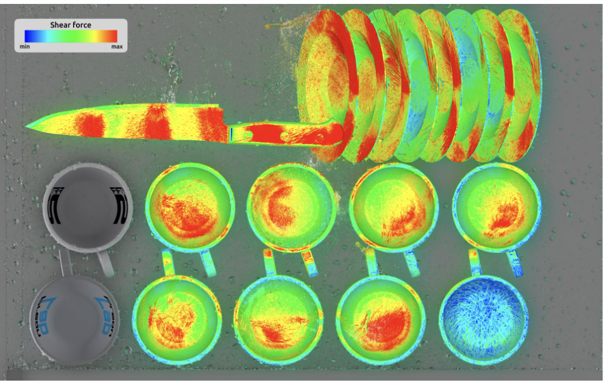

In today’s fast-paced world, where time is a valuable resource, household appliances play a crucial role in our daily lives. Among these, dishwashers stand out as indispensable tools, offering convenience and time-saving benefits. However, optimizing the performance of these machines to ensure thorough and efficient cleaning for a wide range of operating points remains a challenge. With the help of Smoothed-Particle Hydrodynamics (SPH) Preon solver utilized in PreonLab, these engineering challenges can be analyzed and solved in a virtual environment.
Although the primary focus is on achieving clean dishes, in modern dishwashers, a single program is often insufficient to meet all demands. Customers have varying needs and wishes, such as resource or time-saving cleaning cycles, necessitating multiple program options to cater to these diverse preferences. Through the aid of Computational Fluid Dynamics (CFD), we can analyze cleaning efficiency, water and energy usage at different operating conditions, and indirectly influence the duration of these programs even before a prototype is built. These factors are central to many engineering applications aimed at improving dishwasher performance. Let’s delve into each of these aspects and explore how PreonLab can address each of them.
Several aspects of dishwasher design can be analyzed and optimized using simulations, many of which can be explored with PreonLab. For example, design engineers can virtually evaluate design variants to optimize spray nozzles, assess dishware arrangement and rack configurations, analyze fluid and temperature distribution across different operating conditions, and investigate cleaning efficiency in terms of dirt removal and leftover fluid caused by water puddle formation.
Spray arm design optimization is one of the most important tasks in dishwasher analysis. In PreonLab, the rotation of these arms can be either scripted by Key Frame Editor or calculated using Rigid Body Solver (RBS). What sets PreonLab apart is its ability to streamline the process of replacing spray arm designs, eliminating the need for pre-processing or meshing tasks. This convenient workflow for design variants enables efficient testing of multiple spray arm designs and operational configurations.
Video 1: Spray Arm Optimization.
Another critical aspect is optimizing spray arm nozzles, where exit velocity and the pressure in the arm serve as the primary driving forces behind effective soil removal across all dishware surfaces. Similar to spray arm design, nozzle design can be easily updated with minimal effort, enabling iterative simulations of various configurations. By fine-tuning nozzles and consequently flow patterns, engineers can enhance cleaning performance while minimizing water consumption.
Video 2: Spray Nozzle Optimization.
Wetting analysis is a valuable technique for studying flow patterns. By using PreonLab’s wetting sensors, one can identify surfaces that encounter water for different durations. This analysis helps determine if certain surfaces may not receive enough exposure to a spray jet and pinpoint areas prone to water accumulation.

Figure 1: Wetting Time Analysis.
For water to dislodge and rinse away soil effectively, sufficient force must be applied. A crucial metric in assessing cleaning capability is the analysis of shear stress distribution on the dishwasher parts and the dishware. Understanding shear stresses in detail enables the development of dishwasher designs that achieve superior cleaning performance, meeting stringent hygiene standards.

Figure 2: Shear Stress on dishware.
Soil modeling is another critical aspect in dishwasher development. Soil, which consists of food residues and contaminants, behaves similarly to a non-Newtonian fluid during the cleaning process. Its complex rheological properties significantly influence cleaning efficiency and water distribution. By employing a non-Newtonian fluid model, such as the Herschel–Bulkley model, engineers can accurately simulate soil behavior and its interaction with water flow, spray arms, and other dishwasher components.
Video 3: Soil Modeling.
Water temperature plays a pivotal role in determining the effectiveness of a dishwasher, as it directly affects cleaning efficiency. Higher temperatures enhance detergent solubility, accelerate chemical reactions, and soften stubborn residues, making them easier to remove, but also increase electricity consumption. Using conjugate heat transfer (CHT) simulations, engineers can identify the optimal temperature for the water to ensure effective cleaning without excessive heating, balancing energy efficiency with cleaning performance.
Video 4: Temperature Distribution Analysis.
Computational Fluid Dynamics (CFD) is one of the essential tools for the development of a modern dishwasher. Utilizing a particle-based approach, engineers can efficiently simulate fluid flow within dishwashers. With minimal pre-processing, an efficient solver and intuitive workflows for design variations and parameter studies, PreonLab streamlines virtual development. Its utilization not only improves the development process but also contributes to manufacturing dishwashers that are more energy and water-efficient and have better cleaning efficiency.